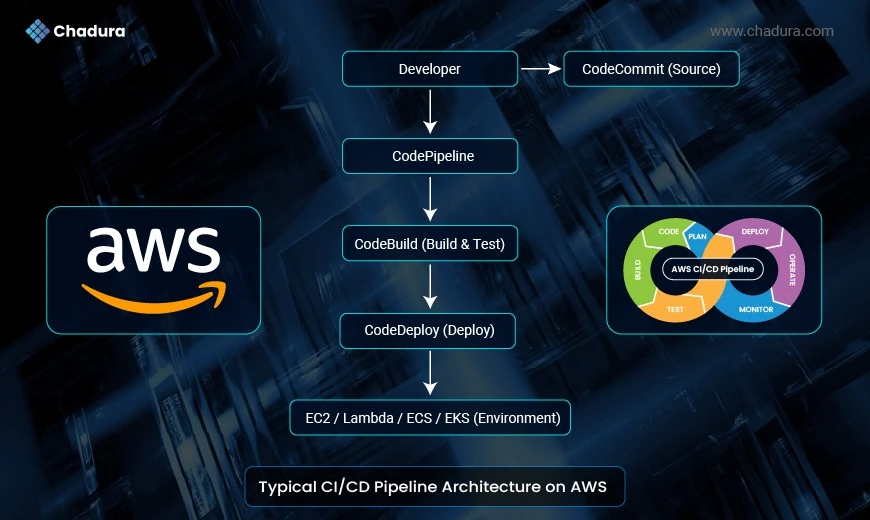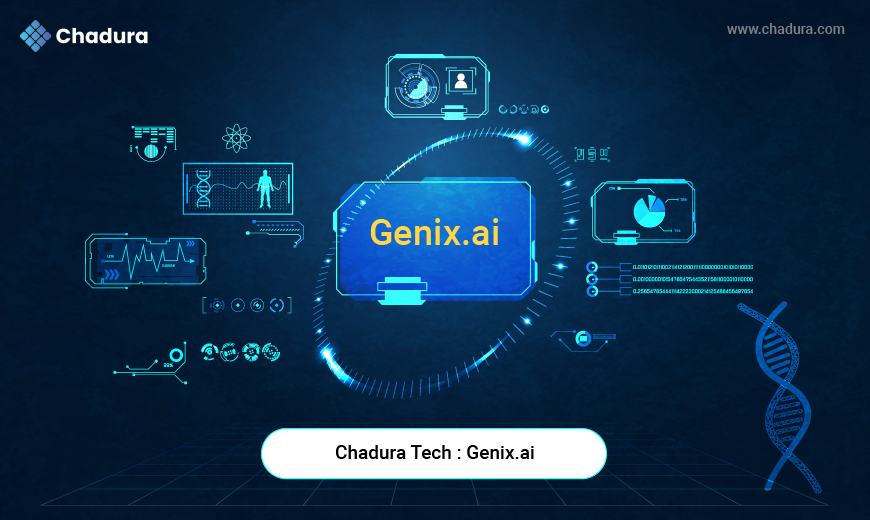What is CI/CD?
- Continuous Integration (CI): The practice of frequently integrating code changes into a shared repository. Each integration is verified by automated builds and tests to detect problems early.
- Continuous Deployment/Delivery (CD): The process of automatically deploying every code change to a staging or production environment after passing automated tests.
Why Choose AWS for CI/CD?
AWS provides end-to-end CI/CD capabilities through fully managed services, enabling teams to build, test, and deploy applications faster. Benefits include:
- Scalability: Automatically scale with workloads.
- Security: Integrated IAM policies and secure artifact storage.
- Flexibility: Integrate with third-party tools and support for multiple languages and platforms.
- Cost-Efficiency: Pay-as-you-go pricing for compute and storage.
Key AWS Services for CI/CD:

AWS CodePipeline
AWS CodePipeline is a cloud-based continuous delivery service. It can automatically compile, build, and test your code, and continuously deliver container-based applications to the AWS cloud. It can perform pre-deployment validation of the artifacts (container images, descriptors, etc.) needed for network service or cloud native network functions.
AWS CodePipeline can also help you run various tests for containerized network function / virtual network function (CNF/VNF), such as baseline and regression testing. You can also use this service to run functional testing, performance testing, and reliability and disaster recovery (DR) testing.
AWS CodeCommit
AWS CodeCommit is a managed source control service that lets you store private Git repositories and various managed assets, including source code, binary files, and documents, in the AWS cloud. The service is highly scalable and secure and eliminates the need to self-manage source control systems and scale the underlying infrastructure.
AWS CodeBuild
AWS CodeBuild is a fully managed continuous integration (CI) service that builds services in the cloud. It compiles source code, runs unit tests, and creates deployment-ready artifacts. There is no need to provision, scale, and manage the build servers—CodeBuild offers pre-packaged build environments for commonly-used programming languages and scales automatically to meet peaks in build requests. It provides build tools like Apache Maven and Gradle and also lets you customize build environments and use your existing build tools.
AWS CodeDeploy
CodeDeploy is a cloud-based deployment service that automatically deploys applications to various targets, including Amazon EC2 instances, serverless Lambda functions, Amazon ECS services, and on-premises instances. It can deploy application content running on a server and stored in GitHub or Bitbucket repositories and Amazon S3 buckets and deploy serverless Lambda functions. There is no need to make changes to your code to use CodeDeploy.
Amazon Elastic Container Registry
Amazon Elastic Container Registry (Amazon ECR) is a fully-managed, cloud-based container image registry service. It provides a scalable, reliable, and secure location for your containers. Amazon ECR lets you use your preferred CLI to pull, push, and manage Docker images, Open Container Initiative (OCI) images, and OCI-compatible artifacts.
The service lets you use AWS Identity and Access Management (IAM) to assign resource-based permissions to your private repositories to ensure only specific users and Amazon EC2 instances are allowed access to container repositories.
AWS CodeStar
AWS CodeStar provides one interface for various development tasks. It lets you create and manage your software development projects on the AWS cloud. You can use CodeStar to develop, build, and deploy your applications in the cloud by creating an AWS CodeStar project. Each project can integrate the relevant AWS services for your toolchain.
AWS CodeStar offers various project templates, each providing a different toolchain. It can include source control, build, virtual servers, deployment, or serverless resources. The service can also manage the permissions allowed for team members (project users). Project owners can add users as team members to their CodeStar project and grant them role-appropriate access to the project and its associated resources.
AWS Lambda
AWS Lambda is a serverless compute service that lets you run code without provisioning or managing servers. You upload your code, and Lambda automatically runs it in response to events like HTTP requests, file uploads, or database changes, scaling automatically as needed.
Amazon EKS (Elastic Kubernetes Service)
Amazon EKS is a managed Kubernetes service that makes it easy to run Kubernetes clusters on AWS without needing to install and operate your own Kubernetes control plane. It helps deploy, manage, and scale containerized applications using Kubernetes.
Amazon ECS (Elastic Container Service)
Amazon ECS is a fully managed container orchestration service that allows you to run and manage Docker containers on a cluster of Amazon EC2 instances or with AWS Fargate (serverless). ECS handles scheduling, scaling, and deploying containers.
Setting Up a CI/CD Pipeline on AWS

Step 1: Define Your Pipeline in AWS CodePipeline:
- In the AWS Management Console, navigate to CodePipeline.
- Click "Create pipeline" and follow the wizard to configure your source, build, and deployment stages.
- Connect your source repository (e.g., AWS CodeCommit, GitHub) and set up a trigger for pipeline execution on code changes.
Step 2: Configure AWS CodeBuild:
- Create a CodeBuild project that aligns with your application's build requirements.
- Define build specifications in a buildspec.yml file to instruct CodeBuild on how to build and package your application.
- Integrate CodeBuild with your CodePipeline by specifying it as the build provider in your pipeline configuration.
Step 3: Implement Deployment with AWS CodeDeploy:
- Configure an AWS CodeDeploy application and deployment group.
- In your CodePipeline, add a deployment stage and select CodeDeploy as the deployment provider.
- Define deployment settings, such as the deployment group and the revision to deploy.
Step 4: Monitor and Enhance:
- Utilize AWS CloudWatch to monitor your pipeline's performance and detect any issues.
- Implement AWS CloudTrail for auditing and tracking changes made to your CI/CD environment.
- Enhance your pipeline gradually by integrating additional testing, security checks, and environment-specific configurations.
Best Practices for AWS CI/CD:
- Parallelize and Distribute Tasks: Distribute tasks across multiple build agents to parallelize processes and reduce build times.
- Automated Testing: Integrate automated testing into your pipeline to ensure code quality and identify issues early.
- Immutable Infrastructure: Treat your infrastructure as code and aim for immutable infrastructure to enhance consistency and repeatability.
- Security Considerations: Implement security checks and scans in your pipeline to identify and address vulnerabilities during the build process.
- Environment Promotion: Use different environments (e.g., development, staging, production) in your pipeline to promote changes through well-defined stages.
Advantages of CI/CD
Faster Delivery
Automation of testing and deployment speeds up the release cycle, allowing faster time to market.
Improved Code Quality
Frequent automated tests catch bugs early, leading to more stable and maintainable code.
Early Bug Detection
Issues are identified early in the development lifecycle, reducing the cost of fixing them.
Reduced Manual Work
Automation minimizes the need for manual testing, builds, and deployments, reducing human error.
Better Collaboration
Developers frequently integrate code, which encourages collaboration and minimizes merge conflicts.
Scalability
CI/CD pipelines can handle large and complex applications across distributed teams and systems.
Increased Customer Satisfaction
Faster updates and more reliable deployments lead to a better user experience.
Disadvantages of CI/CD
Initial Setup Cost
Setting up pipelines, tools, and environments requires time and resources.
Toolchain Complexity
Managing and integrating multiple tools (e.g., Jenkins, GitLab CI, Docker, Kubernetes) can be complex.
Infrastructure Costs
Running automated tests and builds frequently can increase infrastructure usage and costs.
Steep Learning Curve
Teams unfamiliar with CI/CD may need time to learn and adopt best practices effectively.
Maintenance Overhead
CI/CD pipelines require ongoing updates and maintenance to stay effective and secure.
Security Risks
Automated deployments can push insecure or untested code to production if not properly gated.
Conclusion
AWS makes it easy to build and maintain scalable, secure CI/CD pipelines using native tools like CodeCommit, CodeBuild, CodeDeploy, and CodePipeline. With automation and monitoring baked in, developers can focus on writing code while AWS handles the rest of the software delivery lifecycle.
Whether you're managing traditional EC2 applications, containerized workloads, or serverless functions, AWS CI/CD provides the tools and infrastructure to deploy faster and smarter.





